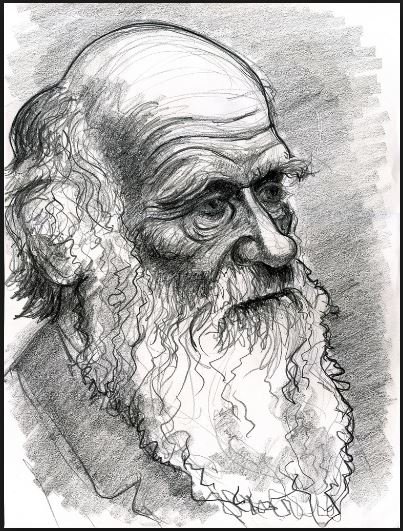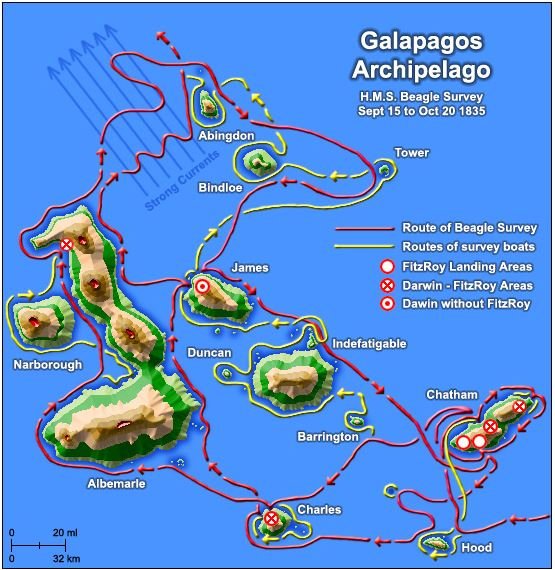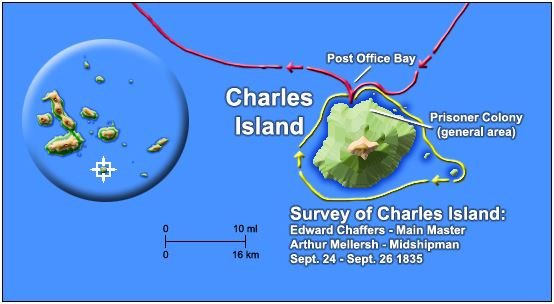TODAY in HISTORY (23 September): Charles Darwin reached Charles Island, one of the Galápagos Islands, in 1835
The HMS Beagle undertook its second voyage from 27 December 1831 to 2 October 1836 under the command of Captain Robert FitzRoy. From his experience on the first voyage, FitzRoy thought it good to invite an expert in geology on board. A young graduate, Charles #Darwin, applied and was accepted by FitzRoy.

FitzRoy planned to sail by the end of September 1831, but due to unplanned delays, he could only lift anchor on 27 December 1831.
The Beagle's survey journey start in the Barn Pool, under Mount Edgecumbe on the west side of Plymouth Sound.
The Beagle stopped at Madeira, the Canary Islands, and the Cape Verde Islands. During this time Darwin tested his net to collect plankton and started to collect different kinds of animals.
After Cape Verde, they crossed the Atlantic ocean to reach South America.
Here the Beagle carried out its survey work going to and fro to along the coasts to allow careful measurement and rechecking. Darwin made long journeys inland. They moved further south where they surveyed the Straits of Magellan before sailing north up the west coast. On 28 June 1384, the Beagle reached the island of Chiloé in the wet and heavily wooded Chonos Archipelago. About a month later they reach Valparaiso where Darwin obtained horses to explore the volcanic Andes with a companion.

On 15 September 1835, the Beagle reached the #Galapagos Islands where they dropped anchor near today’s town of Puerto Baquerizo Moreno on Chatham Island.
Three and a half years had elapsed since the ship's departure from Plymouth, England. Darwin made use of the time to explore the Galapagos especially the island’s volcanic features and collected a broad range of specimens. He was fascinated by the lava and rock formations as well by the islands' reptiles, which included tortoises and iguanas. He collected a variety of flowers and specimens of insects and birds. Darwin also captured an unusual bird which he recognised it as a type of Mockingbird.

On 23 September 1835, they landed on Charles Island where Darwin encountered another Mockingbird which slightly differs from the one he had caught on Chatham Island.
Darwin learned from Nicholas Lawson, governor of a small settlement on Charles Island, that the tortoises on each island also differed slightly - having unique shell form and colour.
According to him, one can tell which island a tortoise came from by looking at its shell. At the time Darwin did not understand the significance of this news.
He became fascinated about the fauna of the Galapagos and gathered a many of specimens of other birds, including finches.
"I industriously collected all the animals, plants, insects & reptiles from this Island. [on Charles Island] It will be very interesting to find from future comparison to what district or 'centre of creation' the organised beings of this archipelago must be attached."
Charles Darwin's Beagle Diary, September 26/27, 1835.
Darwin spent almost a year on the Galapagos to contemplate his findings, and to make detail records of the plants and animals he had collected.
The Beagles return voyage took them past New Zealand and Australia. After visiting Mauritius, they reach the Cape of Good Hope (Cape Town) on 31 May 1836. Here Darwin received a letter from his sister telling him that fame is spreading. They also took the time to visit the noted astronomer Sir John Herschel who was living and working in Cape Town before leaving for England.
On 2 October 1836, the Beagle finally reached Falmouth, Cornwall, England.
Sources:
http://www.aboutdarwin.com/voyage/voyage08.html
http://blogs.britannica.com/2010/09/the-hms-beagle-and-charles-darwin-on-the-shores-of-the-galapagos-islands-picture-essay-of-the-day/
https://en.wikipedia.org/wiki/Second_voyage_of_HMS_Beagle
Excellent work. History rocks. :)
thanks
Looking good over here @krabgat!
We can be like brothers writing our history posts!
Following you now too. :D
Ahhhhh, "They also took the time to visit the noted astronomer Sir John Herschel who was living and working in Cape Town " .... I assume that is where the Herschel Girls High School got its name from...and of course the suburb Observatory where the observatory was located. Nice one @krabgat
Yes, my niece attended Herschel High. That is why included it in the article. :)
An interesting fact which was mentioned in my last visit to the Planetarium in Cape Town is that Herschel named a star constellation 'Table Mountain'. It is the only star constellation which has been named after a physical structure on earth - so they say.
It's interesting that we can study about what someone says but never think about how they lived. I enjoyed the journey.
thank you
I wonder what his thoughts would be today? Would he back his theory?
Is his theory still the same what he intended it to be?